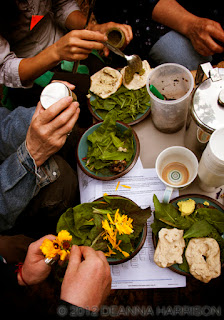What are these weird and wonderful plants for? Are they just for decoration? Do they need special looking after? Why not grow useful, traditional crops?
The answer is that not only are these plants beautiful and interesting, they are also (and these are the criteria for being grown in this garden) good to eat and easy to look after. And Edible Landscapes London’s (ELL’s) aim is to teach the wider community how to grow and eat them.
My interest in this kind of gardening began when I came across Plants for a Future, first published in the early nineties: a fascinating catalogue of a vast range of different plants which I would have never dreamed could be eaten and the result of years of growing and research by its author, Ken Fern. So when I found out that there was a group raising some of the plants I had read about right on my doorstep, I was keen to go along and find out what they were up to. And to see in the flesh plants I had only read about before – like the marvellous walking onion!
On my first visit the pouring rain offered a good reason for an extended lunch, including, as afterwards I kept telling anyone who would listen, ‘the most amazing salad I’ve ever tasted’. Sedum, wild rocket, fennel, sorrel, marguerite leaves, and much more – all just picked from a plot overflowing with colour and taste.
On subsequent visits the rain held off a bit, but the amazing salads and shared lunches continued, around tending the garden. These plants may be good at looking after themselves, but there is still work to be done - especially as one of the ways ELL promotes robust and tasty plants is through its work as a community plant nursery, raising new plants and distributing them to local food-growing projects. After just a few visits I had helped with propagating sedum and fuchsia, spent an enjoyable half hour untangling bindweed from a small hazel tree, and painted up a sign explaining the uses of a hop plant (the young shoots can be steamed and eaten).
Many of us have edible plants growing happily in our garden without our even being aware of it. Roses, sedum, fuchsia, lime trees, hollyhocks, campanula, nasturtiums: parts of all of these plants are edible (check which parts before you cont...
start eating them!). All of this has much more than just amusement value. There is a growing recognition that producing our food locally is an important way of reducing our carbon emissions, as well as often being much healthier than buying tired, plastic-wrapped veg in the supermarket. Forest gardening, which ELL’s plants are ideal for, has a lot to offer, especially in the face of climate change. Not only is a forest garden more ecologically sustainable than a conventional vegetable patch, it is also more resilient in extreme weather conditions: trees protect the smaller plants from strong wind, and permanent root systems hold water and nutrients in the soil, protecting them from drought and flooding. This kind of gardening is also less work, with gardeners spared the repeated tasks of digging over soil, weeding, replanting and regrowing plants each year.
If any of this catches your interest, there are several ways of finding out more. Edible Landscapes London has volunteer days on Mondays and Fridays from 10am to 3pm, and also runs courses on plant identification and tree grafting. Check their website for details: http://transitionfinsburypark.org.uk/NurseryBlog, which also has directions to the site in Finsbury Park.
And if you want to find out more about forest gardening, you could start with Martin Crawford’s How to Grow Perennial Vegetables, with clear advice and plenty of colour photos.
Review: Meg Kelly
Photo: Deanna Harrison
Photo: Deanna Harrison







agness_jacke-210.jpg)


